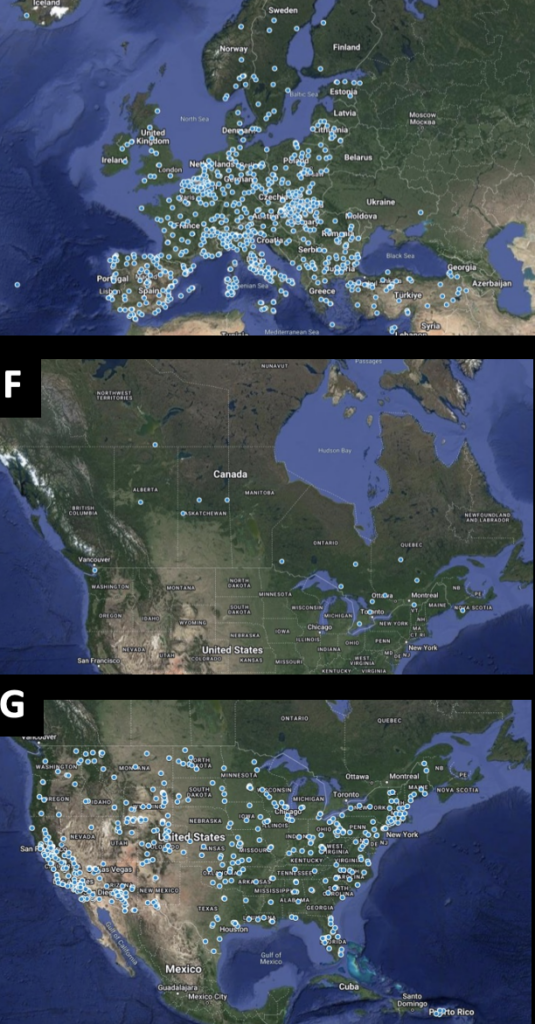
Air-pollution monitors may hold ‘unnoticed’ wealth of biodiversity data
Orla Dwyer
06.05.23Orla Dwyer
05.06.2023 | 4:00pmEnvironmental DNA – sometimes called “forensics for wildlife” – can be collected from the atmosphere using existing air-pollution monitors, according to a new study.
Plants, animals and other organisms shed DNA into soils, water and the air that can be collected and analysed.
Over the past 20 years, researchers have figured out ways to use this data to track a wide range of biodiversity around the world.
But there is currently no global infrastructure network to monitor biodiversity in this way.
The new research, published in Current Biology, finds that air-quality-monitoring systems, thousands of which are already in place in more than 100 countries, potentially already capture and store environmental DNA, or eDNA.
There is an “urgency” to further analyse this possibility on a global scale and better preserve existing data, the study says.
One expert, who was not involved in the study, tells Carbon Brief that the findings are “extremely important and timely”.
But another expert warns that the study may create an “over-expectation” for the possibilities of eDNA analysis.
Biodiversity CSI
Biodiversity is currently declining at the fastest rate in human history.
Globally, wildlife populations decreased by an average of 69% between 1970 and 2016, according to a 2022 WWF report. Climate change is among the key drivers of biodiversity loss.
In December 2022, almost 200 countries signed up in Montreal to a set of goals and targets to “halt and reverse” biodiversity loss by 2030. But achieving these goals requires putting monitoring systems in place to understand how populations are changing.
One tool at scientists’ disposal is the use of environmental DNA.
Environmental DNA can be thought of as “forensics for wildlife”, says Dr David Duffy, an assistant professor of wildlife-disease genomics at the University of Florida. He tells Carbon Brief:
“Essentially every species is continually shedding trace amounts of DNA into the environment.
“[eDNA] is the recovery and analysis of DNA that has been shed from organisms into the environment. It’s been shown that we can recover it from things like air samples, soil samples [and] water samples.”
This DNA is shed in many forms, including skin cells, hair, faeces and scales. It is a useful tool for measuring changes in species range, among other observations, Duffy says.
The technique was first used to analyse past and present biodiversity found in soils and water. It has advanced in recent decades and over the past few years, scientists discovered that eDNA can also be gathered from the air.
Some of the researchers who pioneered the collection of eDNA from air, including Prof Elizabeth Clare from York University, then looked at different ways of gathering this data.
The new study assesses whether airborne eDNA could be captured as a by-product of the regular air-quality-monitoring operations that already exist in many countries – and whether the genetic material on those samples could be retrieved days or weeks later.
Some of these monitors use similar filtration methods to assess levels of air pollution as researchers use to collect eDNA.
The researchers looked at 17 filter samples from two air quality monitoring stations in the UK: one in suburban London and one outside of Edinburgh. These stations use filters to collect particulate matter. The filters are then analysed to determine the level of pollution in the air – a common technique to test air quality.
The samples ranged in time-scale. The London data was gathered from filters over the course of one hour, one day and one week. The Edinburgh samples were gathered over a longer period of time and then stored for eight months before analysis.
When the researchers looked at the samples, they found evidence of 180 plants, fungi, insects, mammals, birds, fish, amphibians and other organisms spread across the two locations. The findings line up with previous data on the types of organisms found in these areas.
‘Ecological significance’
The study findings are “game-changing for our approach to biodiversity-monitoring on land”, the authors write.
The World Air Quality Index project maintains a database of 15,000 air-quality-monitoring stations in 2,000 major cities across 132 countries. But, the study notes, the database does not contain the information necessary to determine which of these stations are compatible with the methods used to gather eDNA.
This map shows the location of air-quality-monitoring stations specifically sampling particulate matter in Europe, Canada and the US.

Clare says that air-pollution monitors have the potential to gather data on “all kinds of different types of life, all at once”. She tells Carbon Brief:
“In our case, everything from fungi and plants, to insects and birds and mammals, and even a newt, were appearing as DNA on these filters.
“Biodiversity is usually studied very specifically for different taxonomic groups and on relatively small scales. The problem is that what we need for everything from modelling biodiversity loss, to our response to international agreements on the preservation of biodiversity, is very, very large-scale measurements.
“We don’t have any large-scale infrastructure in the world that’s really designed for the measurement of biodiversity.”
The study authors contend that air-pollution monitors already gather biodiversity data, with the “ecological significance” of the samples going “unnoticed”.
‘Overselling’
Dr Matthias Obst, an associate professor at the University of Gothenburg and a member of the Swedish eDNA lab, believes there is promise in the findings, but says the study is making “quite a substantial claim” based on small sample sizes. He tells Carbon Brief:
“I like the study, it’s great. I am not so sure I like the way it is presented. I think it’s overselling a lot.
“The conclusion that this would lead to a global – what they claim – biodiversity monitoring programme, I don’t buy that. It’s over the top.”
He says the study may create “hype and an over-expectation” for the method’s potential, which may be difficult to deliver on.
Clare says she and the other researchers are “hoping to sell the enthusiasm that this is a totally new resource – we don’t know what is in these”.
She tells Carbon Brief that the team discussed whether to publish the study now, with limited data, or wait to analyse further samples. But they felt a need to “quickly alert people” to the presence of this possible data, she says, adding:
“In most countries, they literally throw these [filters] away every day, as soon as they’ve taken the measurement.
“One of our reasons for doing this now is to give people a compelling reason to stop doing that. Nobody but us at this point understands the potential ecological value. Some countries archive these, but most don’t, as far as we know.
“What we’re trying to do, putting this out as a small pilot study is to say…until we understand [the filters’] full ecological value, just stop throwing them away, because you may be throwing away something that has a value you haven’t seen.”
Clare adds that there are steps that could easily be taken to better preserve eDNA on these samples, such as storing them dry, instead of wet, or storing them in a freezer, rather than at room temperature.
Location, location
Dr Melanie Kolb, a researcher at the National Autonomous University of Mexico, says the study adds more evidence to the “great versatility” of eDNA. She tells Carbon Brief:
“In this sense, the proposal of the paper offers to be hugely efficient, as no further resources for sampling and monitoring are required to obtain a completely new and different kind of information.”
But Kolb, and other experts who spoke to Carbon Brief about this study, also raised concerns about the location of existing air-pollution monitors.
Populated areas, which monitor air quality for their citizens, are “not necessarily the areas where biodiversity needs to be monitored” the most, Kolb says.
So while the findings may advance methods in biodiversity monitoring in certain capacities, Kolb believes they may “not contribute to diminish existing biases among the global south – but [instead] deepen them”. She adds:
“For certain contexts, it is a significant advancement, but not for the areas, regions or countries where most biodiversity is harboured and biodiversity loss is rampant.”
Obst notes a similar concern: questioning who will pay for monitors to be located in less-populated areas for studying biodiversity.
Clare points out that air-quality monitors already exist in both urban and rural areas. Many are located in national parks, she says, and “places that you would consider quite biologically valuable”. She adds:
“As far as we can tell from what is public data, they are not all clustered around urban areas. They’re actually interestingly distributed in ways that make them quite potentially ecologically valuable.
“Some of them may be more or less easy for us to access the material, but they’re all sampling very set particle sizes. As long as they’re sampling at that size range, it’s almost certain that they’re capturing [eDNA]. It just becomes an issue of how to actually access the material that’s on them.”
She adds that the research team spoke to experts in biodiverse countries in the global south about the possibilities of the findings before publishing the study.
Future possibilities
Duffy says the “inventive” study “opens up a whole range of possibilities” for gathering eDNA through the air. He tells Carbon Brief:
“You don’t need a given specialist in every group of animals or plants to understand what’s present and how it’s changing over time…By assessing the DNA of those species, you can identify what’s there with a single assay.”
Duffy was involved in a recent study looking at the benefits and ethical concerns behind the gathering of human genetic information alongside environmental DNA. He says:
“That is definitely linked to this study, where these monitors may well be picking up human DNA as bycatch.”
Dr Deborah Dawson, the manager of a genetics research facility at the University of Sheffield, says the findings are “exciting” and demonstrate an eDNA collection method with “huge potential”. She tells Carbon Brief:
“The recognition and proof that air-pollution monitors can be used to study biodiversity is an extremely important and timely finding.”
Dawson highlights the importance of building on these findings to “set standard protocols to regularly and systematically record and compare biodiversity in different regions across our planet, and monitor the changes expected in the UK and around the world due to climate change”.
Questions remain about exactly how far eDNA is able to travel through the air before being collected by air-pollution monitors, according to the study and experts who spoke to Carbon Brief about its findings. This range depends on particle and filter size.
The study also notes that more research is needed on how eDNA degrades over time on filters before they are collected and properly stored.
Clare adds that this method of monitoring eDNA could open a “whole new scale of what we can measure” around biodiversity.
This could range from tracking populations migrating due to climate change, the arrival of new species and detecting rare species that may be missed through a single measurement. She tells Carbon Brief:
“This is an incredible potential resource for trying to understand not just the presence and absence of species, but the movement of populations.”
Littlefair et al. (2023), Air-quality networks collect environmental DNA with the potential to measure biodiversity at continental scales, Current Biology, doi:10.1016/j.cub.2023.04.036





